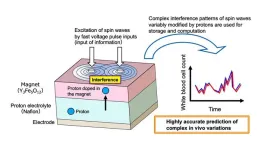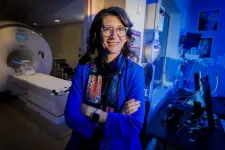(Press-News.org) Cardiovascular disease (CVD) is the leading cause of morbidity and mortality globally, posing a particularly significant threat to people with HIV (PWH). To address this, CVD prevention plans rely on prediction models like atherosclerotic cardiovascular disease (ASCVD) risk scores to estimate the risk of heart disease.
However, previous studies have called into question whether these commonly used prediction models perform well among people with HIV, and there remains a gap in understanding of what these scores mean for PWH in low- and middle-income countries (LMICs).
Researchers from Massachusetts General Hospital, a founding member of the Mass General Brigham healthcare system, in collaboration with an international team of investigators, conducted a study to evaluate how well existing ASCVD risk estimates could be used to predict cardiovascular outcomes in global populations with HIV. Their findings are published in Lancet HIV.
Their prospective cohort study used data from Randomized Trial to Prevent Vascular Events in HIV (REPRIEVE) to analyze individuals with HIV who were from low-, middle-, and high-income countries across several continents. The researchers found that for those in REPRIEVE, current risk models underestimated cardiovascular events in both women and black men in high income countries (HICs), while overestimating cardiovascular events for all PWH in LMICs.
“These findings allow researchers to fine-tune cardiovascular disease prediction models for people living with HIV,” said Patrice Desvigne-Nickens, MD, a medical officer within the National Heart, Lung, and Blood Institute (NHLBI). “Assessing the accuracy of these predictions in subgroups of the population is possible because of carefully developed outreach and enrolling a diverse study population – representing all people at risk.”
Steven Grinspoon, MD, a co-lead study author and chief of the Massachusetts General Hospital Metabolism Unit in the Endocrinology Division of the Department of Medicine, agrees. “This study underscores the need for nuanced, region-specific and population-specific CVD prediction models that accurately reflect cardiovascular risk for PWH, including those living in LMICs,” he explained.
“Our team calculated correction factors for the underestimates, with future work needed to validate these values in an external cohort. We anticipate that experts on guideline committees will recognize our findings and may consider stronger treatment recommendations for women and black or African American men living with HIV in HICs,” said co-lead author Markella Zanni, MD, director of Women's Health Research in the Metabolism Unit at Massachusetts General Hospital.
END
Global HIV study finds that cardiovascular risk models underestimate for key populations
Mass General Brigham researchers found that for people with HIV in the REPRIEVE trial, current risk models underestimated cardiovascular events in both women and black men in high-income countries.
2025-01-18
ELSE PRESS RELEASES FROM THIS DATE:
New study offers insights into how populations conform or go against the crowd
2025-01-17
Cultural traits — the information, beliefs, behaviors, customs, and practices that shape the character of a population — are influenced by conformity, the tendency to align with others, or anti-conformity, the choice to deliberately diverge. A new way to model this dynamic interplay could ultimately help explain societal phenomena like political polarization, cultural trends, and the spread of misinformation.
A study published in the Proceedings of the National Academy of Sciences outlines this novel approach. Presenting a mathematical model, SFI Complexity Postdoctoral Fellow Kaleda Denton with colleagues ...
Development of a high-performance AI device utilizing ion-controlled spin wave interference in magnetic materials
2025-01-17
A research team from NIMS and the Japan Fine Ceramics Center (JFCC) has developed a next-generation AI device—a hardware component for AI systems—that incorporates an iono-magnonic reservoir. This reservoir controls spin waves (collective excitations of electron spins in magnetic materials), ion dynamics and their interactions. The technology demonstrated significantly higher information processing performance than conventional physical reservoir computing devices, underscoring its potential to transform AI technologies.
As AI devices become increasingly sophisticated, ...
WashU researchers map individual brain dynamics
2025-01-17
By Shawn Ballard
The complexity of the human brain – 86 billion neurons strong with more than 100 trillion connections – enables abstract thinking, language acquisition, advanced reasoning and problem-solving, and the capacity for creativity and social interaction. Understanding how differences in brain signaling and dynamics produce unique cognition and behavior in individuals has long been a goal of neuroscience research, yet many phenomena remain unexplained.
A study from neuroscientists and ...
Technology for oxidizing atmospheric methane won’t help the climate
2025-01-17
As the atmosphere continues to fill with greenhouse gases from human activities, many proposals have surfaced to “geoengineer” climate-saving solutions, that is, alter the atmosphere at a global scale to either reduce the concentrations of carbon or mute its warming effect.
One recent proposal seeks to infuse the atmosphere with hydrogen peroxide, insisting that it would both oxidize methane (CH4), an extremely potent greenhouse gas while improving air quality.
Too good to be true?
University of Utah atmospheric scientists Alfred Mayhew and Jessica Haskins were skeptical, so they set out to test the claims behind this proposal. Their results, published on ...
US Department of Energy announces Early Career Research Program for FY 2025
2025-01-17
WASHINGTON, D.C. – Today, the U.S. Department of Energy (DOE) announced it is accepting applications for the 2025 DOE Office of Science Early Career Research Program to support the research of outstanding scientists early in their careers. The program will support over 80 early career researchers for five years at U.S. academic institutions, DOE national laboratories, and Office of Science user facilities.
“The vision, creativity, and effort of early career faculty drive innovation in the basic science enterprise. The Department of Energy’s Office of Science is dedicated to ...
PECASE winners: 3 UVA engineering professors receive presidential early career awards
2025-01-17
University of Virginia School of Engineering and Applied Science faculty members James T. Burns, Coleen Carrigan and Liheng Cai received the Presidential Early Career Award for Scientists and Engineers (PECASE) on Tuesday, as did two UVA Engineering alumni, Ashutosh Giri and Ryan Johnson.
PECASE is the highest honor bestowed by the U.S. government on outstanding scientists and engineers early in their careers. According to the release from the White House, this award recognizes “innovative and far-reaching developments in science and technology.”
“This award year has been extraordinary not ...
‘Turn on the lights’: DAVD display helps navy divers navigate undersea conditions
2025-01-17
ARLINGTON, Va.—A favorite childhood memory for Dr. Sandra Chapman was visiting the USS Arizona Memorial in Pearl Harbor with her father. They hung out at the memorial so often that they memorized lines to the movie playing prior to the boat ride to the memorial.
So it’s appropriate that Chapman — a program officer in the Office of Naval Research’s (ONR) Warfighter Performance Department — is passionate about her involvement in the development of an innovative technology recently applied to efforts to preserve the area around the USS Arizona ...
MSU researcher’s breakthrough model sheds light on solar storms and space weather
2025-01-17
Images
EAST LANSING, Mich. – Our sun is essentially a searing hot sphere of gas. Its mix of primarily hydrogen and helium can reach temperatures between 10,000 and 3.6 million degrees Fahrenheit on its surface and its atmosphere’s outermost layer. Because of that heat, the blazing orb constantly oozes a stream of plasma, made up of charged subatomic particles — mainly protons and electrons. The sun’s gravity can’t contain them because they hold so much energy as heat, so they drift away into space as solar wind. Understanding how charged particles ...
Nebraska psychology professor recognized with Presidential Early Career Award
2025-01-17
Maital Neta, professor of psychology at the University of Nebraska–Lincoln, has received the Presidential Early Career Award for Scientists and Engineers, the highest honor bestowed by the U.S. government on outstanding scientists and engineers early in their careers.
Neta, Carl A. Happold Professor of Psychology, directs the Cognitive and Affective Neuroscience Lab and is resident faculty of the Center for Brain, Biology and Behavior.
Neta said she was “very grateful” for the honor, announced ...
New data shows how ‘rage giving’ boosted immigrant-serving nonprofits during the first Trump Administration
2025-01-17
As Donald Trump prepares to take office for a second term as President, research led by the University of California, Santa Cruz is demonstrating the important role nonprofits played during Trump’s first term as a counterforce that channeled public resistance to anti-immigrant policies.
The new study, published in the journal International Migration Review, shows how nonprofits that provide legal services for immigrants ended up receiving increases in public contributions in the wake of Trump's attacks on immigrants.
Previously, there had been many reported examples of this backlash effect, sometimes called ...
LAST 30 PRESS RELEASES:
Can community awareness campaigns in low-resource areas improve early diagnosis of colorectal cancer?
Stardust study resets how life’s atoms spread through space
Practical education: Clinical scenario-based program development
The impact of family dynamics on eating behaviour – how going home for Christmas can change how you eat
Tracing the quick synthesis of an industrially important catalyst
New software sheds light on cancer’s hidden genetic networks
UT Health San Antonio awarded $3 million in CPRIT grants to bolster cancer research and prevention efforts in South Texas
Third symposium spotlights global challenge of new contaminants in China’s fight against pollution
From straw to soil harmony: International team reveals how biochar supercharges carbon-smart farming
Myeloma: How AI is redrawing the map of cancer care
Manhattan E. Charurat, Ph.D., MHS invested as the Homer and Martha Gudelsky Distinguished Professor in Medicine at the University of Maryland School of Medicine
Insilico Medicine’s Pharma.AI Q4 Winter Launch Recap: Revolutionizing drug discovery with cutting-edge AI innovations, accelerating the path to pharmaceutical superintelligence
Nanoplastics have diet-dependent impacts on digestive system health
Brain neuron death occurs throughout life and increases with age, a natural human protein drug may halt neuron death in Alzheimer’s disease
SPIE and CLP announce the recipients of the 2025 Advanced Photonics Young Innovator Award
Lessons from the Caldor Fire’s Christmas Valley ‘Miracle’
Ant societies rose by trading individual protection for collective power
Research reveals how ancient viral DNA shapes early embryonic development
A molecular gatekeeper that controls protein synthesis
New ‘cloaking device’ concept to shield sensitive tech from magnetic fields
Researchers show impact of mountain building and climate change on alpine biodiversity
Study models the transition from Neanderthals to modern humans in Europe
University of Phoenix College of Doctoral Studies releases white paper on AI-driven skilling to reduce burnout and restore worker autonomy
AIs fail at the game of visual “telephone”
The levers for a sustainable food system
Potential changes in US homelessness by ending federal support for housing first programs
Vulnerability of large language models to prompt injection when providing medical advice
Researchers develop new system for high-energy-density, long-life, multi-electron transfer bromine-based flow batteries
Ending federal support for housing first programs could increase U.S. homelessness by 5% in one year, new JAMA study finds
New research uncovers molecular ‘safety switch’ shielding cancers from immune attack
[Press-News.org] Global HIV study finds that cardiovascular risk models underestimate for key populationsMass General Brigham researchers found that for people with HIV in the REPRIEVE trial, current risk models underestimated cardiovascular events in both women and black men in high-income countries.




